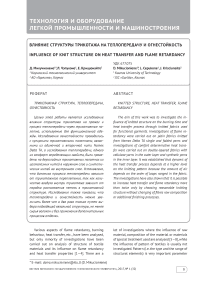Влияние структуры трикотажа на теплопередачу и огнестойкость
Автор: Микучионене Дайва, Чэпуконе Лина, Крищюнайте Елита
Журнал: Вестник Витебского государственного технологического университета @vestnik-vstu
Рубрика: Технология и оборудование легкой промышленности и машиностроения
Статья в выпуске: 1 (32), 2017 года.
Бесплатный доступ
Целью этой работы является исследование влияния структуры трикотажа на прожог и процесс теплопередачи через трикотажные полотна, используемые для функциональной одежды. Исследования огнестойкости проводились с кулирными трикотажными полотнами, вязанными из одиночной и вторичной нити Nomex Delta TA, а исследования теплопередачи, одного из комфорт определяющих свойств, были проведены на двухслойных трикотажных полотнах из целлюлозных нитей в наружном слое и синтетических нитей во внутреннем слое. Установлено, что динамика процесса теплопередачи зависит от трикотажного переплетения, так как количество воздуха внутри трикотажа зависит от порядка расположения петель в трикотажной структуре. Исследования также показали, что теплопередача и огнестойкость можно увеличить более чем в два раза только путем выбора подходящей вязальной структуры, не меняя сырья волокон и без применения дополнительных процессов отделки.
Трикотажная структура, теплопередача, огнестойкость
Короткий адрес: https://sciup.org/142185000
IDR: 142185000 | УДК: 677.075
Текст научной статьи Влияние структуры трикотажа на теплопередачу и огнестойкость
KNITTED STRUCTURE, HEAT TRANSFER, FLAME RETARDANCY
The aim of this work was to investigate the influence of knitted structure on the burning time and heat transfer process through knitted fabrics used for functional garments. Investigations of flame re-tardancy were carried out on plain fabrics knitted from Nomex Delta TA single and folded yarns and investigations of comfort determinative heat transfer were carried out on double-layered fabrics with cellulose yarns in the outer layer and synthetic yarns in the inner layer. It was established that dynamic of the heat transfer process depends at a higher level on the knitting pattern because the amount of air depends on the order of loops ranged in the fabric. The investigations have also shown that it is possible to increase heat transfer and flame retardancy more than twice only by choosing reasonable knitting structure without changing of fibres raw composition or additional finishing processes.
Various aspects of flame retardancy, burning behaviour, heat transfer, etc., have been analysed, but only minority of investigations have been carried out on analysis of structure of textile materials and its influence on flame retardancy and heat transfer properties [1—4]. There are a lot of investigations where the influence of raw material, composition of the material or materials of special treatment used are analysed [5—8], while the influence of pattern of textiles is usually not investigated. Pattern (i.e. the type and the range of structural elements) is very important parameter for various physical and mechanical properties of textiles, such as strength, elasticity, stiffness, air and water permeability, and other. Flame retardancy and heat transfer process are also strong related to the knitting or weaving pattern. The volumetric structure of cloth, i.e. the quantity and shape of various inter channels and pores in the textile structure, depends on the pattern of textile. The yarn diameter, knitting structure, course and wale density are the main factors, affecting porosity of the knitted fabrics. The porosity can influence flame retardancy or heat transfer process in a positive as well as in a negative way – air contains oxygen, which supports flame. On the other hand, air is the best thermal insulator and air without oxygen is the best flame retardant.
Consumers of the protective clothing are becoming increasingly demand on the comfortability of textiles. A state of comfort can be achieved through the complex interaction between a range of psychological, physiological and physical factors taken place in a satisfactory manner [8, 9]. Clothing comfort includes three main considerations: thermo-physiological (thermal comfort), sensorial (dryness-wetness, fineness-roughness, etc.) and psychological comfort (well-being) [10, 11]. With higher level of heat, generated by the body, heat transfer through the clothing often is insufficient to compensate for the body’s energy balance, human begins to sweat and it causes annoyance feeling or even more – a cold after physical activity [10]. The heat transfer mechanism, i.e. conduction, convection and radiation, are well known and all of them coexist in the heat transfer process from a heated surface through a porous textile material attached onto it [12]. Most of the studies have been devoted to evaluation of static thermal properties of woven and knitted fabrics, and only few investigations have been made in the field of the heat transfer process through the knitted fabrics. However, heat transmission through the textiles over the time is very important for a consumer.
Protective clothing has a direct influence on a worker’s comfort conditions during his activity. Therefore, the protective efficiency of the clothing must be compatible with the comfort properties, despite the fact that the requirement for adequate protection is usually contradictory to the requirement for adequate ventilation. Therefore, investigations on the influence of structural parameters on fabric properties and creation of the fabric design in accordance with the characteristics determined are very topical. Unfortunately, in recent time there is a tendency that structural investigations are usually forgotten, narrowing to simplest patterns of fabrics and not estimating the significance of their structural parameters.
The main goal of this work was to determine the influence of structural characteristics on flammability and thermal properties and to increase flame retardancy of knit without decreasing of garment comfortability. This paper presents significance of the knit structure on the complex of properties, combining decreased flammability and increased comfortability. This is an essential difference from similar studies, which are usually limited to either the flame retardancy or comfortability investigations.
The structural characteristics of knitted fabrics tested are presented in Table 1, and the knitting structure – in Figure 1.
Investigations on heat transfer characteristics have been carried out on the double-layered fabrics knitted in single jersey plated pattern and two types of combined structure on a circular knitting machines in a gauge E22 from cotton yarns in outer layer (located outer from the skin) and polypropylene PP, polyamide PA, polyester PES, and Coolmax (tetra–channel fibres by DuPont) yarns in inner layer.
Investigations on burning time have been carried out on two groups of plain single jersey fabrics knitted on a circular knitting machine in a gauge E14 from Nomex Delta TA yarns, which are usually used for fire-protective clothing manufacture. Fabrics of the first group ( 1YSJ ) have been made from the single Nomex Delta TA yarn with 37 tex total linear density. Fabrics of the second group ( 2YSJ ) have been made from the two-fold assembled Nomex Delta TA yarns, i.e. with 74 tex total linear density. In both groups, three variants of knits with different loop length (4.80, 5.70, and 6.90 mm ) have been manufactured (see Table 1). Three combinations of packets from knits of the first group 1YSJ (single layer, two layers of the single knit, and four layers of the single
|
Table 1 - Main structural characteristics of knitted fabrics tested |
||||
|
Sample code |
Pattern |
Raw material, linear density of yarns in tex and percentage composition |
Loop length in mm |
Area density in g/m2 |
|
1YSJ1 |
Single jersey |
Nomex Delta TA, 37 tex, 100% |
4.80 |
135 |
|
1YSJ2 |
Single jersey |
Nomex Delta TA, 37 tex, 100% |
5.70 |
111 |
|
1YSJ3 |
Single jersey |
Nomex Delta TA, 37 tex, 100% |
6.90 |
92 |
|
2YSJ1 |
Single jersey |
Nomex Delta TA, 37 tex × 2, 100% |
4.80 |
317 |
|
2YSJ2 |
Single jersey |
Nomex Delta TA, 37 tex × 2, 100% |
5.70 |
270 |
|
2YSJ3 |
Single jersey |
Nomex Delta TA, 37 tex × 2, 100% |
6.90 |
216 |
|
SJ1 |
Single jersey plated |
Cotton, 20 tex, 71% + PA, 7.8; 29% |
2.84 |
229 |
|
SJ2 |
Single jersey plated |
Cotton, 20 tex, 71% + Coolmax, 7.8; 29% |
2.79 |
222 |
|
SJ3 |
Single jersey plated |
Cotton, 20 tex, 71% + PES, 8.3; 29% |
2.79 |
227 |
|
SJ4 |
Single jersey plated |
Cotton, 20 tex, 71% + PP, 8.4; 29% |
2.88 |
234 |
|
FP1 |
French piqué |
Cotton, 20 tex, 71% + PA, 7.8; 29% |
3.11 |
158 |
|
FP2 |
French piqué |
Cotton, 20 tex, 71% + Coolmax, 7.8; 29% |
3.10 |
158 |
|
FP3 |
French piqué |
Cotton, 20 tex, 71% + PES, 8.3; 29% |
3.10 |
160 |
|
FP4 |
French piqué |
Cotton, 20 tex, 71% + PP, 8.4; 29% |
3.21 |
163 |
|
C1 |
Combined |
Cotton, 20 tex, 71% + PA, 7.8; 29% |
3.24 |
134 |
|
C2 |
Combined |
Cotton, 20 tex, 71% + Coolmax, 7.8; 29% |
3.26 |
137 |
|
C3 |
Combined |
Cotton, 20 tex, 71% + PES, 8.3; 29% |
3.26 |
139 |
|
I C4 |
Combined |
Cotton, 20 tex, 71% + PP, 8.4; 29% |
3.35 |
140 ____J |
Note: the relative error of all measurements is less than 5 %.
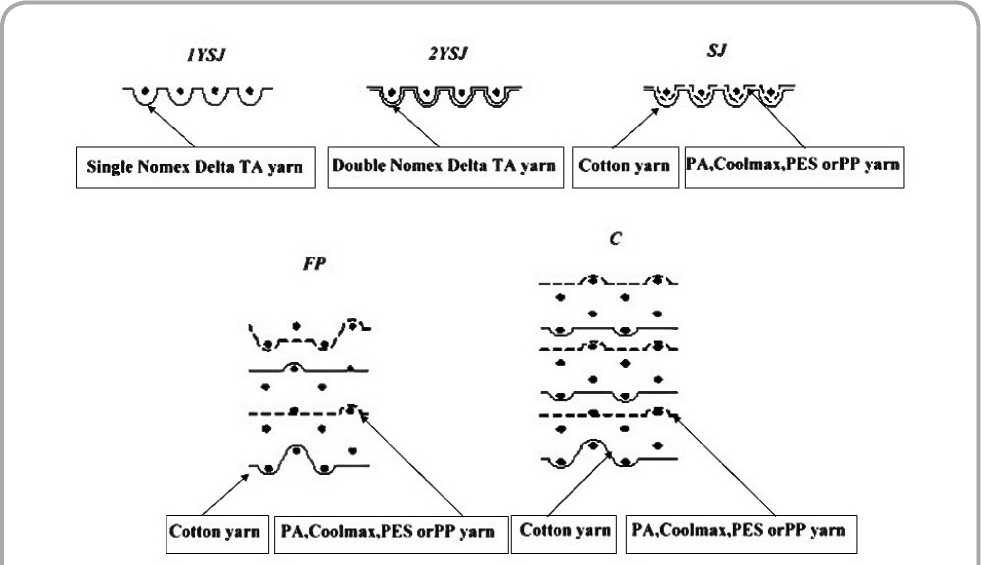
Figure 1 - Pattern of knitted fabrics investigated knit) and two combinations of packets from knits of the second group 2YSJ (single layer and two layers of the single knit) have been used in the investigations of flammability.
All experiments have been carried out in a standard atmosphere for testing according to the standard ISO 139:2005. Structure parameters of knitted samples (loop length, wale and course density, and area density) have been analysed according to the British Standard BS 5441:1998. Thickness of the knitted samples has been measured in accordance with ISO 5084:1996 standard. Relative error of these measurements did not exceed 3 %. Thermal conductivity has been determined with a measuring device precisely described in [13]. Temperatures have been registered using an ALMEMO 2590–9 device with microprocessor data processing and accumulation system. The resolving power of the device is 0.1 °C . The variation coefficient of the temperature measurements did not exceed 3.7 %. All measurements have been repeated six times at randomly chosen parts of the samples. Relative error values of the thermal conductivity coefficient have been calculated and found to range from 3.5–11.8 %.
The heat interchange (heat transfer dynamic) dependence on the structure and raw material of the knitted fabrics have been investigated using an IG/ISOC (Giuliani Technologies, Italy) device designed for the establishing of heat insulation. The measurement error of the digital thermometer with a platinum thermo sensor was equal to ± (0.071 ^ 0.076) ° C . The knitted fabric was laid down on a heated plate and a thermo sensor was superimposed on the outward side of the fabric. The plate was heated up to 40 °C , and the temperature was recorded every 10 seconds. Changes in temperature were observed for 14 minutes and recorded every 10 seconds until alteration of the results were within the margins of error.
Flammability of the knits has been investigated using the horizontal test method according to standard DIN 50050-1:1989, which is applicable to all textile materials. In accordance with the procedure, a fabric specimen was clamped wrinkle free between two plates in a horizontal position. The horizontal flammability test was used, and the burning time from the start until the knit breakup was measured. The height of the flame was 4 cm and the distance between the flame source and materials investigated was 2 cm. Average values of the tests were calculated from the five measurements. Relative error of the measurements of burning time did not exceed 5 %.
Two series of investigations with the different types of knits have been carried out: one type of knitted fabrics is used for fire-fighter’s clothing, and another one for high activity clothing. For consumers of workwear and protective clothing, the ability of clothing to release heat from the body to the environment is very important, because the quick exchange of heat allows the well-being. Even a few tithes of temperature degree can influence the health and well-being of a human [10, 13].
Various combinations of natural and synthetic yarns are very popular for clothing used for high activity. There were the thermal conductivity and thermal resistance of double-layered fabrics knitted from cotton yarns and four types of synthetic yarns (PA, PES, Coolmax, an PP) in three different knitting patterns (see Fig. 1) investigated in this work. Natural fibres, such as cotton, bamboo or wool, are hygroscopic and, therefore, characterised by high absorption levels. On the other hand, cotton fabrics hold absorbed water, and their moisture transfer property is not especially high during activity. This retention of water may increase the weight of the garment as well as impair heat dissipation from the skin and post-activity evaporative cooling. Synthetic fibres, such as polyester, polypropylene and acrylic, are not hygroscopic and, therefore, only absorb a comparatively small amount of moisture. However, because of their hydrophilic fibre surface, they have a high moisture transfer rate. A combination of natural and synthetic fibre yarns is an optimal solution when designing clothing for high activity [9, 10].
The results of investigation are presented in Table 2. As it can be seen from the results presented, difference between the thermal characteristics (thermal conductivity and thermal resistance) of double-layered knitted fabrics investigated depending on the raw material of the yarns are not high, only 4÷9 %. The influence of knitting pattern on the thermal characteristics, however, is much higher. The fabrics knitted in French piqué and combined patterns (FP and C respectively) have up to 25 % higher thermal conductivity coefficient and up to 80 % higher thermal resistance as fabrics knitted in single jersey plated pattern (SJ). This is because French piqué and combined structures are not so tight, loops in such structure fabrics are ranged in two separate layers connected just in some points, whereas all loops in single jersey plated fabrics are knitted from two yarns and densely arranged in one line (see Fig.1). The thickness of single jersey plated fabrics is also lower than of French piqué and combined fabrics (see Table 2).
The results of measurement of heat transfer through the double-layered knitted fabrics SJ, FP, and C , depending on raw material and knitting structure, are presented in Figures 2 and 3. The curves present average values calculated from five tests for each knit at each time point (the coefficient of variation of the measurements ranges from 0.84 % to 2.51 %).
As it is shown in Figure 2, the process of heat transfer through the double-layered knits can be described by logarithmic equation with high coefficients of determination. However, the impact of the raw material composition of knitted fabric on the dynamic of heat transfer through the fabrics investigated is very low. This means that the raw materials of yarns that are commonly used for such kind of clothing do not have perceptible influence on heat transfer dynamic.
The influence of knitting structure on heat transfer through the double-layered knitted fabrics investigated is shown in the Figure 3.
As shown in Figure 3, the influence of knitting structure on the heat transfer dynamic is evident. The same situation has been found with all the combinations of yarns investigated, what merely confirms that heat transfer through the single jersey plated knitted fabrics is apparently faster than through the fabrics with parallel doublelayered (French piqué and combined) structures. In the single jersey plated knits all loops are ranged in one layer (while knitted on the same needle bed), whereas in the French piqué and combined structures (knitted on a double needle bed) the loops are ranged in two parallel layers, connected only in certain places. The amount of air in such double-layered structures is much higher than in the single jersey knits. It is well known that air is the best thermal insulator. For the present, the results of heat transfer through the both, French piqué and combined, double-layered structures are very close, as the type and order of the structural elements in the patterns is very similar.
Hence, it may be concluded that for clothing providing protection against heat the doublelayered knitted structures have to be chosen, while single jersey knitted structures have to be used
|
Table 2 – Thermal characteristics of double-layered knitted fabrics tested |
|||
|
Sample code |
Thermal conductivity coefficient in W/mK |
Thermal resistance in m2K/W |
Thickness, mm |
|
SJ1 |
0.052 |
0.013 |
0.617 |
|
SJ2 |
0.053 |
0.016 |
0.692 |
|
SJ3 |
0.054 |
0.013 |
0.646 |
|
SJ4 |
0.054 |
0.015 |
0.661 |
|
FP1 |
0.047 |
0.018 |
0.908 |
|
FP2 |
0.047 |
0.020 |
1.142 |
|
FP3 |
0.047 |
0.017 |
0.988 |
|
FP4 |
0.043 |
0.017 |
1.028 |
|
C1 |
0.043 |
0.024 |
1.243 |
|
C2 |
0.043 |
0.028 |
1.474 |
|
C3 |
0.043 |
0.023 |
1.268 |
|
к C4 |
0.040 |
0.026 |
1.392 _______J |

Time t, s
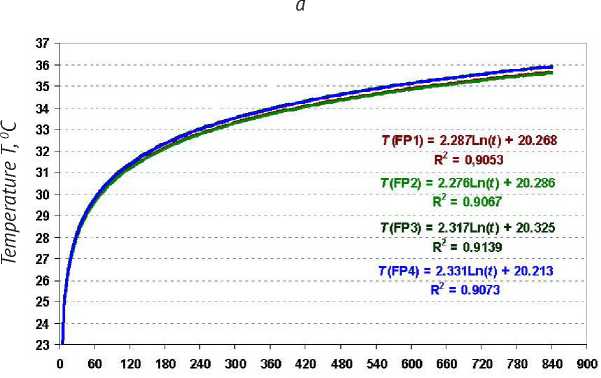
Time t, s b
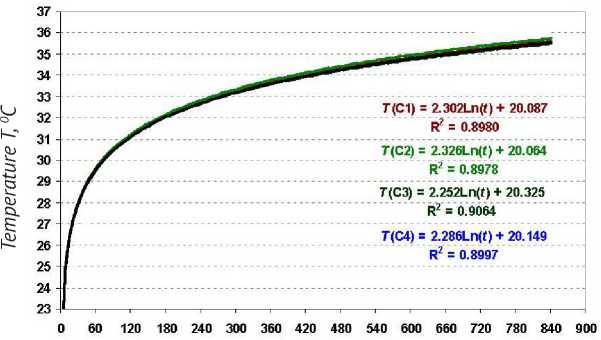
Time t, s c
Figure 2 – Dependence of heat transfer dynamic on raw composition of knitted fabrics with structure of: a) single jersey plated ( SJ ); b) French piqué ( FP ); c) combined ( C )
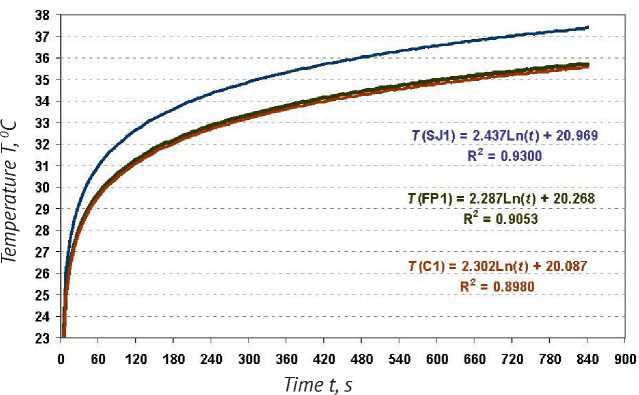
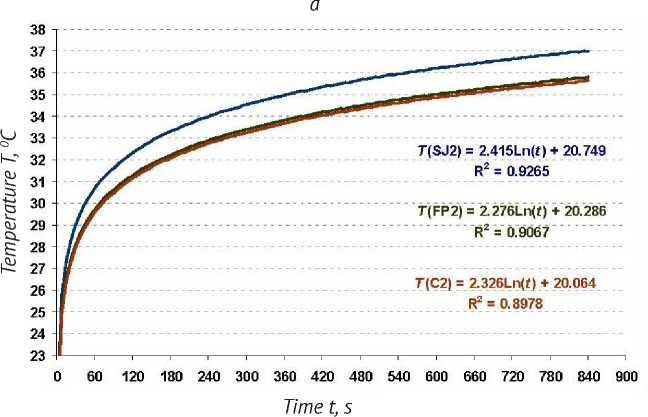
b
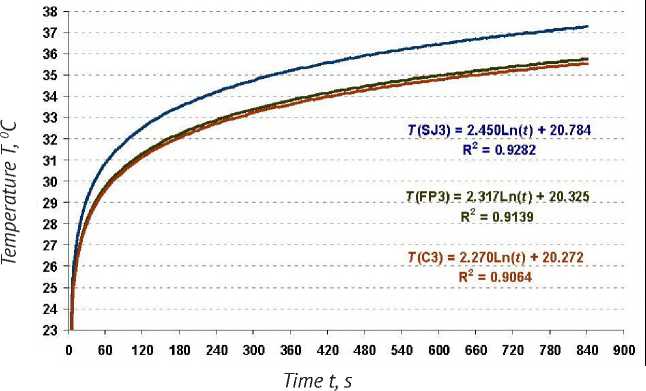
c
Figure 3 – Dependence of heat transfer dynamic on knitting structure of fabrics knitted from cotton and PA (a),
Coolmax (b), PES (c) yarns combination: SJ1 – single jersey plated structure; FP – French piqué structure;
C – combined structure
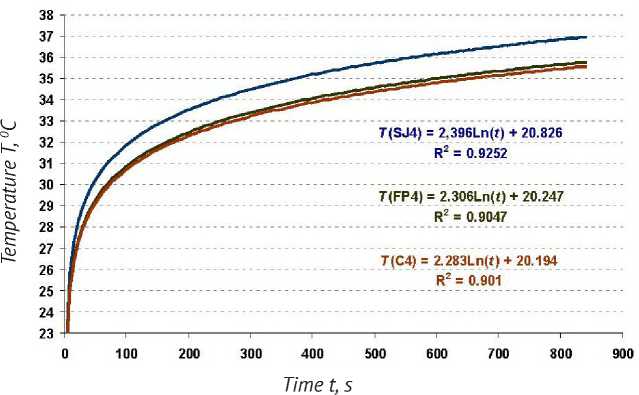
d
Figure 3 – Dependence of heat transfer dynamic on knitting structure of fabrics knitted from cotton and PP (d) yarns combination: SJ1 – single jersey plated structure; FP – French piqué structure; C – combined structure
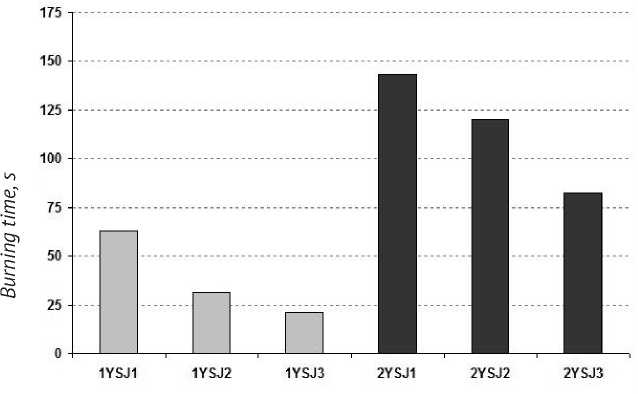
Figure 4 – Influence of loop length and number of yarns in the loop on burning time of knitted fabric
when high amount of heat needs to be released.
Investigations of the structure influence on flammability also show high importance of textiles’ structure. The dependence of burning time on the loop length as well as on the number of yarns in the loop of fabrics knitted from Nomex Delta TA yarns is presented in Figure 4.
As seen from the results in Figure 4, the reduced loop length can decrease burning time of the knit more than three times: when the loop length decreases 1.4 times (from 6.9 mm of the sample 1YSJ1 till 4.8 mm of the sample 1YSJ3), the burning time decreases even 3 times. This influence is not so high than of the knits made of two-folded yarns (the variant 2YSJ) – in this case the burning time increases in approximately 1.7
times. This is because of tighter structure.
The influence of higher yarn linear density on the burning time (when using two-folded yarns) is very well visible in Figure 5, where the view of the knits after 60 sec of burning is presented. The sample knitted from the single Nomex Delta TA yarn (the variant 1YSJ2) is apparently destroyed, while surface of the sample knitted from two-folded yarns with the same loop lengths as in previous variant (the variant 2YSJ2) is not damaged and still can protect user from the flame source.
The difference of burning time between different knits of the same variant (single yarn or two-folded yarns) can be explained by increase of the surface density (mass per square unit) of the knit. On the other hand, the surface density of variants of 1YSJ1 (4 layers) and 2YSJ2 (2 layers) have the same 540 g/m2 density but the burning time of these knits is absolutely different.

Figure 5 – Flammability resistance of knits of the variant 1YSJ2 (a) and the variant 2YSJ2 (b) after 60 sec
of burning
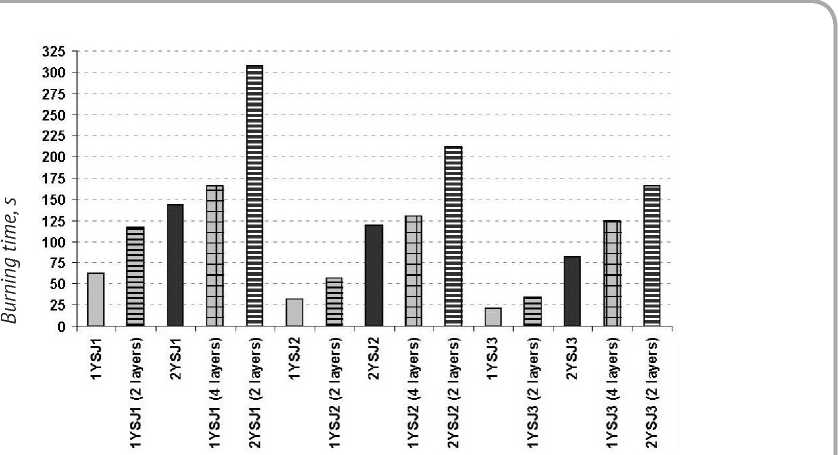
Figure 6 – Dependence of burning time on knitting structure and number of layers of knitted fabrics
It is well known that the burning time and thermal insulation (i.e. protective properties) of the garment increases, when the number of textile fabric layers in the packet increases [1, 9]. However, when comparing the burning time of single layer of knitted fabric made from single or two-folded yarns with the burning time of multilayered packet, it is found that protective properties of the single layered fabric with tighter structure is much higher than of the multilayered packet (see Figure 6).
Analysing various variants presented in Figure 6, it was established that burning time of the packet of 2 layers of 1YSJ1 fabric (knitted from the single Nomex Delta TA yarn with the loop length 4.8 mm ) is in 20 % lower than of the one layered fabric 2YSJ1 (knitted from the two-folded Nomex Delta TA yarn with the same loop length – 4.8 mm ). Even more, burning time of the packet of 4 layers of 1YSJ1 fabric is in 45 % higher than of the packet of 2 layers of 2YSJ1 fabric. The same situation has been found for the knits with the higher loop length – 5.7 and 6.9 mm , though for textiles with looser structure these differences are little bit lower. In any case, manufacturing process of two knits will be twice more expensive than of the one knit with two yarns in the loop. Hence, the usage of two yarns in the loop will be more costeffective than using a packet with two layers.
So, it is evident that the surface density is not the main parameter, on which the burning time depends - the structure of a fabric is not less important than surface density. It can be noted that when using two-folded yarns in the loop it is possible to achieve higher flame retardancy of a garment than using single yarns, even without increasing of total surface density of a garment. Such phenomenon arises due to air gaps between the yarns. After folding, yarns never contact in whole area between them, the small air gap exists in all the cases [9]. At the time of burning, oxygen in these pores very quickly is used for flaming and, without oxygen the gaps, becomes the good flame retardant. The problem in predicting the burning time using models of knits depends on chaotic structure of two-folded yarns. The yarns after folding are not in parallel lines in the whole length. In some parts they are twisted, in some parts – untwisted, they could lay one on the other as well as one beside other. This situation makes theoretical modelling very sophisticated and practically not usable. Due to that the empirical investigations of various variants of knits made from single and folded yarns (two, three or more) in combined patterns need to be carried out. These investigations will be the next step of our further works.
CONCLUSION
Process of heat transfer through the doublelayered weft knits can be described by logarithmic equation – the coefficients of determination of equations are not lower than 0.89. The influence of knitting structure on heat transfer dynamic through the knitted fabric is much higher than the influence of the raw materials investigated. Heat transfer through the single jersey plated knitted fabrics is apparently faster than through the double-layered fabrics with French piqué and similar combined structures. In the single jersey plated knit, all loops are ranged in one layer, whereas in the French piqué and combined structures the loops are ranged in two layers, connected only in certain places. Due to that, the double-layered knitted structures are more suitable for clothing providing protection against heat, and the single jersey knitted structures have to be used when heat needs to be fast released.
Influence of the knitting structure is very important for flame retardancy of protective garment as well. The reduced loop length can decrease burning time of the knit even three times, and using two-folded yarns it is possible to achieve higher flame retardancy of a garment than using single yarns, even without increasing of total surface density of a garment. Area density of the fabric is not the main parameter, on which the burning time depends. The structure of a fabric is not less important than area density. Investigations in the field of structure influence on the flame retardancy are very important and need to be carried out in further works.
Список литературы Влияние структуры трикотажа на теплопередачу и огнестойкость
- Sirvydas, P.A., Nadzeikiene, J., Milasius, R., Eicinas, J., Kerpauskas, P. (2006), The Role of the Textile Layer in the Garment Package in Suppressing Transient Heat Exchange Processes, Fibres&Textiles in Eastern Europe, 2006, № 2, pp. 55-58.
- Mikucioniene, D., Milasiute, L., Baltusnikaite, J., Milasius, R. (2011), Influence of the Number of Yarns in a Loop on the Flammability of Knits, Fibres&Textiles in Eastern Europe, 2011, № 6, pp. 71-74.
- Glombikova, V., Komarkova, P. (2013), The Efficiency of Non-Flammable Functional Underwear, AUTEX Research Journal, 2014, № 3, pp. 174-178.
- Uçar, N., Yilmaz, T. (2004), Thermal Properties of 1×1, 2×2, 3×3 Rib Knit Fabrics, Fibres&Textiles in Eastern Europe, 2004, № 3, pp. 34-38.
- Gilewicz, P., Dominiak, J., Cichocka, A., Frydrych, I. (2013), Change in Structural and Thermal Properties of Textile Fabric Packages Containing Basalt Fibres after Fatigue Bending Loading, Fibres&Textiles in Eastern Europe, 2013, № 5, pp. 80-84.
- Long, Z.F., Feng, Q.Q., Liu, R., Yu, B., Zhou, Y. (2015), Enhancing the Thermal Protective Performance of Firefighters' Protective Fabrics by Incorporating Phase Change Materials, Fibres&Textiles in Eastern Europe, 2015, № 2, pp. 68-73.
- Cui, Z., Ma, Ch., Na, L. (2015), Effects of Heat Treatment on the Mechanical and Thermal Performance of Fabric Used in Firefighter Protective Clothing, Fibres&Textiles in Eastern Europe, 2015, № 2, pp. 74-78.
- Oglakcioglu, N., Marmarali, A. (2007), Thermal Comfort Properties of Some Knitted Structures, Fibres&Textiles in Eastern Europe, 2007, № 5, pp. 94-96.
- Abramaviciute, J., Mikucioniene, D., Ciukas, R. (2011), Static Water Absorption of Knits from Natural and Textured Yarns, Fibres&Textiles in Eastern Europe, 2011, № 3, pp. 60-63.
- Bivainyte, A., Mikucioniene, D. (2011), Investigation on the Dynamic Water Absorption of Double-Layered Weft Knitted Fabrics, Fibres&Textiles in Eastern Europe, 2011, № 6, pp. 64-70.
- Sanches, R.A., Takamune, K.M., Guimaraes, B.M. (2015), Comparative Study of the Characteristics of Knitted Fabrics Produced from Recycled Fibres Employing the Chauvenet Criterion, Factorial Design and Statistical Analysis, Fibres&Textiles in Eastern Europe, 2015, № 4, pp. 19-24.
- Matusiak, M. (2010), Thermal Comfort Index as a Method of Assessing the Thermal Comfort of Textile Materials, Fibres&Textiles in Eastern Europe, 2010, № 2, pp. 45-50.
- Bivainyte, A., Mikucioniene, D., Kerpauskas, P. (2012), Investigation on thermal properties of double -layered weft knitted fabrics, Material Science (Medziagotyra), 2012, № 2(18), pp. 167-171.

